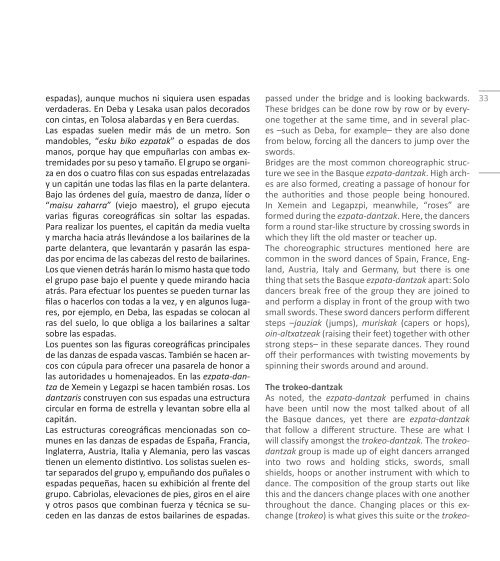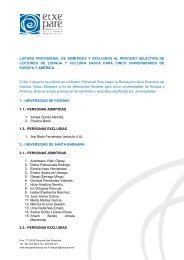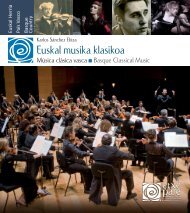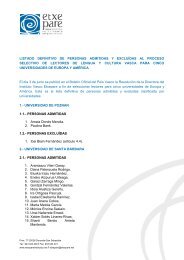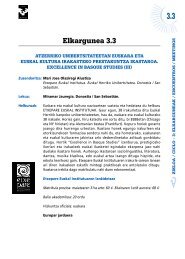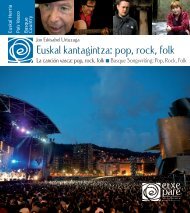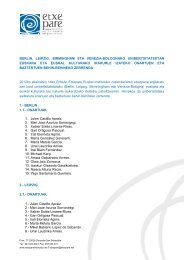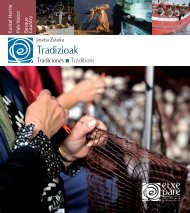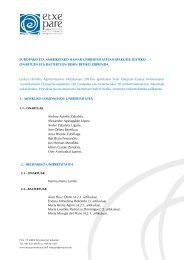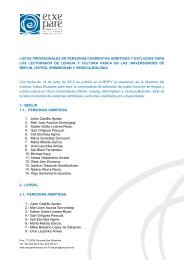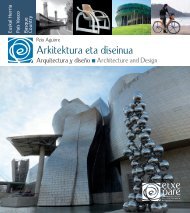Euskal dantza - Etxepare, Euskal Institutua
Euskal dantza - Etxepare, Euskal Institutua
Euskal dantza - Etxepare, Euskal Institutua
Create successful ePaper yourself
Turn your PDF publications into a flip-book with our unique Google optimized e-Paper software.
espadas), aunque muchos ni siquiera usen espadasverdaderas. En Deba y Lesaka usan palos decoradoscon cintas, en Tolosa alabardas y en Bera cuerdas.Las espadas suelen medir más de un metro. Sonmandobles, “esku biko ezpatak” o espadas de dosmanos, porque hay que empuñarlas con ambas extremidadespor su peso y tamaño. El grupo se organizaen dos o cuatro filas con sus espadas entrelazadasy un capitán une todas las filas en la parte delantera.Bajo las órdenes del guía, maestro de danza, líder o“maisu zaharra” (viejo maestro), el grupo ejecutavarias figuras coreográficas sin soltar las espadas.Para realizar los puentes, el capitán da media vueltay marcha hacia atrás llevándose a los bailarines de laparte delantera, que levantarán y pasarán las espadaspor encima de las cabezas del resto de bailarines.Los que vienen detrás harán lo mismo hasta que todoel grupo pase bajo el puente y quede mirando haciaatrás. Para efectuar los puentes se pueden turnar lasfilas o hacerlos con todas a la vez, y en algunos lugares,por ejemplo, en Deba, las espadas se colocan alras del suelo, lo que obliga a los bailarines a saltarsobre las espadas.Los puentes son las figuras coreográficas principalesde las danzas de espada vascas. También se hacen arcoscon cúpula para ofrecer una pasarela de honor alas autoridades u homenajeados. En las ezpata-<strong>dantza</strong>de Xemein y Legazpi se hacen también rosas. Los<strong>dantza</strong>ris construyen con sus espadas una estructuracircular en forma de estrella y levantan sobre ella alcapitán.Las estructuras coreográficas mencionadas son comunesen las danzas de espadas de España, Francia,Inglaterra, Austria, Italia y Alemania, pero las vascasenen un elemento disnvo. Los solistas suelen estarseparados del grupo y, empuñando dos puñales oespadas pequeñas, hacen su exhibición al frente delgrupo. Cabriolas, elevaciones de pies, giros en el airey otros pasos que combinan fuerza y técnica se sucedenen las danzas de estos bailarines de espadas.passed under the bridge and is looking backwards.These bridges can be done row by row or by everyonetogether at the same me, and in several places–such as Deba, for example– they are also donefrom below, forcing all the dancers to jump over theswords.Bridges are the most common choreographic structurewe see in the Basque ezpata-<strong>dantza</strong>k. High archesare also formed, creang a passage of honour forthe authories and those people being honoured.In Xemein and Legapzpi, meanwhile, “roses” areformed during the ezpata-<strong>dantza</strong>k. Here, the dancersform a round star-like structure by crossing swords inwhich they li the old master or teacher up.The choreographic structures menoned here arecommon in the sword dances of Spain, France, England,Austria, Italy and Germany, but there is onething that sets the Basque ezpata-<strong>dantza</strong>k apart: Solodancers break free of the group they are joined toand perform a display in front of the group with twosmall swords. These sword dancers perform differentsteps –jauziak (jumps), muriskak (capers or hops),oin-altxatzeak (raising their feet) together with otherstrong steps– in these separate dances. They roundoff their performances with twisng movements byspinning their swords around and around.The trokeo-<strong>dantza</strong>kAs noted, the ezpata-<strong>dantza</strong>k perfumed in chainshave been unl now the most talked about of allthe Basque dances, yet there are ezpata-<strong>dantza</strong>kthat follow a different structure. These are what Iwill classify amongst the trokeo-<strong>dantza</strong>k. The trokeo<strong>dantza</strong>kgroup is made up of eight dancers arrangedinto two rows and holding scks, swords, smallshields, hoops or another instrument with which todance. The composion of the group starts out likethis and the dancers change places with one anotherthroughout the dance. Changing places or this exchange(trokeo) is what gives this suite or the trokeo-33


